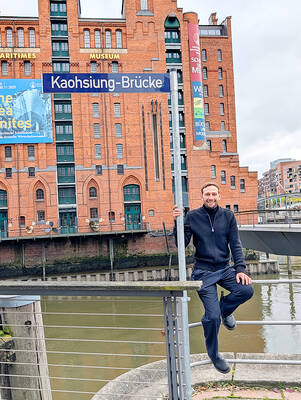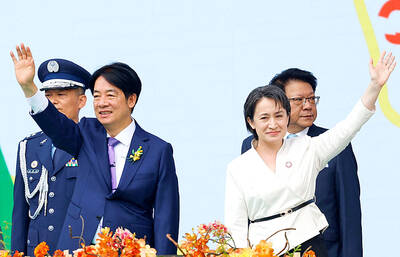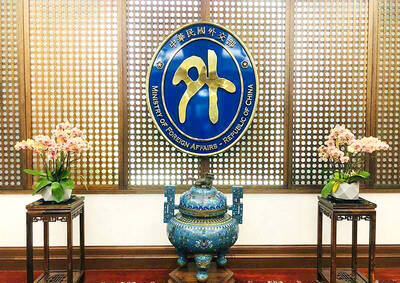The next president of the US should “do everything in his power” to ensure that political integration between Taiwan and China remains a “far-off prospect,” a new analysis says.
Written by American Enterprise Institute (AEI) researcher Shannon Mann, the analysis was published this week on the Web site PolicyMic, which is aimed at people in their 20s — the so-called millennials — interested in US foreign policy.
PolicyMic claims to have writers in 35 countries and more than 6 million unique monthly readers.
For many of those readers, Mann’s analysis may be their first significant introduction to the Taiwan-China issue.
Promises by the administration of US President Barack Obama to deepen economic and military ties with allies in the Asia-Pacific region have fallen flat in the light of budgetary realities, Mann says.
Defense cuts totaling nearly US$1 trillion over the next decade “expose the gap between the White House’s unrealistic expectations and the reality of limited resources,” and no other ally is left more vulnerable than Taiwan, Mann says.
In the past five years, Beijing has used its influence to dissuade other countries from signing trade agreements with Taiwan and Taipei has been led into deep economic ties with China, while Chinese leaders have openly stated that economic relations with Taiwan are part of an “embedded reunification” strategy, Mann says.
“Today, the American punditocracy believes that Taiwan’s reunification with China through intensifying economic reliance is inevitable,” Mann says. “If Taiwan integrates with China, however, US strategic interests in Asia will be greatly diminished both for the US and for our regional allies.”
Should China take over Taiwan it would win major advantages, including radar sites to search for US Navy ships in the Pacific and a deep-water naval base at Suao.
The Pratas Reef would extend China’s jurisdiction another 320km and control of Itu Aba Island (Taiping Island, 太平島) in the Spratly Islands (Nansha Islands, 南沙群島) would provide another military base in contested waters, Mann says.
Most importantly, the Taiwan Strait would become an inland waterway allowing Beijing to block Japanese and South Korean access to vital sea lanes.
“Even in the face of tremendous budget cuts, it is time to re-evaluate our policy towards mainland China and Taiwan,” Mann says. “Subsequent US administrations should help Taiwan become a member of the Trans-Pacific Partnership to decrease its economic reliance on China, as well as increase joint military training exercises.”
“The bottom line is that Taiwan can’t fall off the strategy-making table — tactics that encourage Taiwan to remain politically less ‘Chinese’ are necessary for US security in Asia,” Mann concludes.

The German city of Hamburg on Oct. 14 named a bridge “Kaohsiung-Brucke” after the Taiwanese city of Kaohsiung. The footbridge, formerly known as F566, is to the east of the Speicherstadt, the world’s largest warehouse district, and connects the Dar-es-Salaam-Platz to the Brooktorpromenade near the Port of Hamburg on the Elbe River. Timo Fischer, a Free Democratic Party member of the Hamburg-Mitte District Assembly, in May last year proposed the name change with support from members of the Social Democratic Party and the Christian Democratic Union. Kaohsiung and Hamburg in 1999 inked a sister city agreement, but despite more than a quarter-century of

Taiwanese officials are courting podcasters and influencers aligned with US President Donald Trump as they grow more worried the US leader could undermine Taiwanese interests in talks with China, people familiar with the matter said. Trump has said Taiwan would likely be on the agenda when he is expected to meet Chinese President Xi Jinping (習近平) next week in a bid to resolve persistent trade tensions. China has asked the White House to officially declare it “opposes” Taiwanese independence, Bloomberg reported last month, a concession that would mark a major diplomatic win for Beijing. President William Lai (賴清德) and his top officials

The Ministry of Foreign Affairs (MOFA) yesterday expressed “grave concerns” after Singaporean Prime Minister Lawrence Wong (黃循財) reiterated the city-state’s opposition to “Taiwanese independence” during a meeting with Chinese Premier Li Qiang (李強). In Singapore on Saturday, Wong and Li discussed cross-strait developments, the Singaporean Ministry of Foreign Affairs said in a statement. “Prime Minister Wong reiterated that Singapore has a clear and consistent ‘one China’ policy and is opposed to Taiwan independence,” it said. MOFA responded that it is an objective fact and a common understanding shared by many that the Republic of China (ROC) is an independent, sovereign nation, with world-leading

‘ONE CHINA’: A statement that Berlin decides its own China policy did not seem to sit well with Beijing, which offered only one meeting with the German official German Minister for Foreign Affairs Johann Wadephul’s trip to China has been canceled, a spokesperson for his ministry said yesterday, amid rising tensions between the two nations, including over Taiwan. Wadephul had planned to address Chinese curbs on rare earths during his visit, but his comments about Berlin deciding on the “design” of its “one China” policy ahead of the trip appear to have rankled China. Asked about Wadephul’s comments, Chinese Ministry of Foreign Affairs spokesman Guo Jiakun (郭嘉昆) said the “one China principle” has “no room for any self-definition.” In the interview published on Thursday, Wadephul said he would urge China to